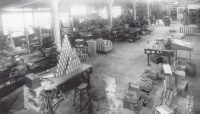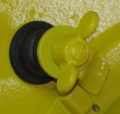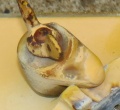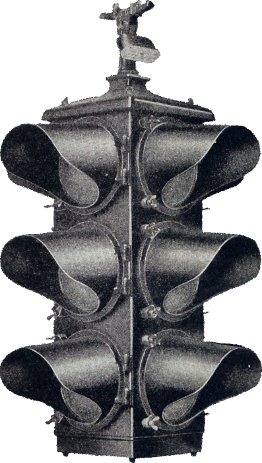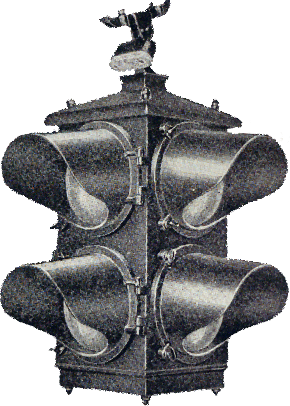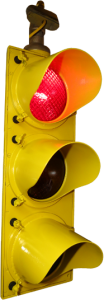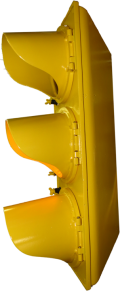Difference between revisions of "American Crucible"
(→Corporate History and Overview) |
(→Latch Variations) |
||
| Line 44: | Line 44: | ||
<gallery mode="nolines"> | <gallery mode="nolines"> | ||
File:AmCr_Latch_LC.jpg|Stamped/Boot Style | File:AmCr_Latch_LC.jpg|Stamped/Boot Style | ||
| + | File:AmCr_Latch2_LC.jpg|Most Common Spring/Cast Style | ||
</gallery> | </gallery> | ||
</div> | </div> | ||
Revision as of 18:52, 10 January 2014
Contents
Corporate History and Overview
Traffic Signals
Design Characteristics
The traffic signals they produced were robust and had several notable design characteristics.
- Were said to have a sun phantom proof design.
- Early lights featured an angled bulb mount while later ones had the industry standard straight bulb configuration.
- Metal reflectors heavily chromium plated. Signals taken out of service 80 years later still have bright reflectors.
- Orange peel type lenses (the same styles used in Darley except a blue instead of green "green" lens.)
- Sealed, "dustproof" construction with lens and door gaskets.
- Early models featured cast cap visors, later signals were available with cast tunnel/circle visors and removable rolled aluminum visors.
- Signals with removable cast visors are the final version produced by the Traffic Master Company or The Master Equipment Corp. around 1939 in Amherst, Ohio.
- Marketed as "light weight" and weatherproof.
- Lights with a thin bottom plate were controlled externally, lights with a large bottom section had an integrated controller.
- Early signals were built from single piece side plates, later versions used used a stackable design to allow easy configuration of 1-4 signal sections.
There may have been a different, early design of traffic light that was marketed in the early 1928-1930 timeframe. All the known documentation and specimens are indicative of the lights as seen from the 1930's to 1940's. The information contained in this article as of publishing time represents this single series of known lights produced.
Door Variations
During the course of production the most marked change to the signal was the branding as presented on the door.
- The earliest versions [1928-1930?] were of a solid body/cast visor design with no markings present on the door.
- Solid body/cast visor design with: THE MASTER SIGNAL THE AMERICAN CRUCIBLE PRODUCTS CO. LORAIN O. U.S.A.
- Cast visor sectional body style: THE MASTER SIGNAL U.S.A.
- Sectional body/removable rolled visor design with no markings present on the door.
- Sectional body/removable cast visors [1939?]: The Traffic Master Co Elyria O
Four Ways
Model S-3-29
Model S-2-29
This is the presumed model number for this variant.
Pedestrian Signals
describe models, variations
Vehicle Heads (Round)
describe models, variations
Vehicle Heads (Square Door Adapters)
describe models, variations
Pedestrian/Sign Heads (Rectangular)
describe models, variations
Informational Signals and Signs
describe models, variations [delete] includes "box signs," "case signs," and Ped Heads with special [non-ped] lenses.
Lenses
describe models, variations
Vehicular
The earlier lights used orange peel lenses, like used in Darley lights, except the green aspect was a blue lens, instead of a green lens. These were typically made by Jefferson or Brilliant.
Later lights used Corning Type-E Large Bead lenses.
Pedestrian
describe models, variations
Worded
describe models, variations
Symbols
describe models, variations
Special
describe models, variations
Controllers
- Split amber operation - only the green light traffic sees the amber.
- Single cam, induction motor mechanical controllers.
- Sealed gear system.
- Tungsten contacts with a sliding self cleaning action for longer life.
- Unique RED-I-FLASH system where a flashing red light above green indicates a signal change for two color signals.
- Single wire, impulse controlled coordination system.
- Masterless coordination system, any controller serves as master.
- Self lubricating bronze bearings.
- Positive starting in cold temperatures
Special Features Available:
- Emergency Control
- Manual Control
- Flashing or Night Amber mode
- Pedestrian Controls
- Coordination for Two and Three Period Controls
Hardware
This would include any kind of mounting hardware including brackets, slipfitters, hangers, bases, etc.
Miscellaneous Images
Various reference images, restored examples, etc. that don't fit anywhere else.
Relevant Patents
Patent numbers relevant to this MFR or signals specifically. Not just every patent by company X.
References
- Lorain - Images of America: Ohio, Black River Historical Society, Arcadia Publishing, 1999, ISBN 0738501786, ISBN 9780738501789
- Google Map Imagery, September 2013
Notes for Larry
File:File.jpg to use the full version of the file
to use a 200 pixel wide rendition in a box in the left margin with 'alt text' as description
Media:File.ogg for directly linking to the file without displaying the file
AmCr_Ext_LC.jpg
AmCr_Int_LC.jpg
AmCr_Strtbulb_LC.jpg
latch2
AmCr_Ctrlr_LC.jpg
AmCr_Angbulbin_LC.jpg
AmCr_Hanger_LC.png
The Prospect Fire Engine Company
The early ones from the 20's had glass reflectors and the body was little bit different
They made them in solid body also
Besides boyd they marketed them under a different name also. I dont think they ever put the boyd name on them just switched the name on the ad.
They were in 3 cities in the Cleveland area.
The later ones had straight bulbs like the newer ones.
There common in Ohio, Many towns once had them.
They started in 1924 and redesigned there lights in 1939
Came with orange peel Jefferesons and Brilliants, then 27's and type E lenses
Later cast doors didnt have a name
later ones did away with the ornamental brass square on top
Thumbscrews, Wingnuts, cast latches, stamped latches

